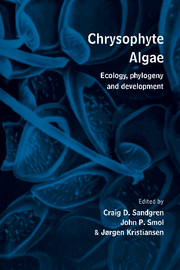Book contents
- Frontmatter
- Contents
- Preface
- List of contributors
- 1 History of chrysophyte research: origin and development of concepts and ideas
- Part I Phylogeny, systematics and evolution
- Part II Development, physiology and nutrition
- Part III Ecology, paleoecology and reproduction
- Part IV Contributed original papers
- Index of scientific names
- Subject index
Preface
Published online by Cambridge University Press: 05 March 2012
- Frontmatter
- Contents
- Preface
- List of contributors
- 1 History of chrysophyte research: origin and development of concepts and ideas
- Part I Phylogeny, systematics and evolution
- Part II Development, physiology and nutrition
- Part III Ecology, paleoecology and reproduction
- Part IV Contributed original papers
- Index of scientific names
- Subject index
Summary
Research activity involving algae in the algal classes Chrysophyceae and Synurophyceae (collectively, ‘chrysophytes’) has increased dramatically over the last decade. Chrysophyte algae are primarily freshwater flagellate organisms that typically constitute a dominant or subdominant portion of the phytoplankton biomass in lakes with moderate to low productivity. They have long been under-studied by aquatic ecologists because of difficulties in culturing and preserving chrysophytes, and because of the tendency to study eutrophic, human-impacted lake systems in which chrysophytes are relatively rare. However, the critical importance of chrysophytes in carbon flux through oligotrophic, freshwater food webs has been the subject of considerable recent research. The mixotrophic nutritional capacity of most chrysophytes provides them with a distinct advantage in nutrient-poor lakes. Chrysophyte-rich lakes are often poorly buffered and are thus sensitive to anthropogenic acidification. Because of the extreme interest in lake acidification in both North America and Europe, siliceous chrysophyte microfossils (resting cysts, cell scale layers) have rapidly become primary paleolimnological research tools. Chrysophyte microfossil research has, in turn, stimulated considerable renewed interest in their biogeography and in environmental factors influencing seasonal and spatial distribution patterns. This activity has revealed fundamental gaps in our knowledge of chrysophyte nutritional physiology and basic metabolism. Chrysophyte algae also continue to occupy a central position with regard to evolutionary relationships among groups of chromophyte, chlorophyll a and c containing algae (diatoms, chrysophytes, brown algae, dinoflagellates, etc.) and also in linking chromophytes to several non-photosynthetic protistan groups (amoebae, heliozoans, choanoflagellates, oomycete molds). These relationships have been the subject of considerable ultrastructural phylogenetic research over the last 15 years, and chrysophytes continue to be pivotal in current molecular phylogenetic studies of photosynthetic protists.
- Type
- Chapter
- Information
- Chrysophyte AlgaeEcology, Phylogeny and Development, pp. ix - xiPublisher: Cambridge University PressPrint publication year: 1995



